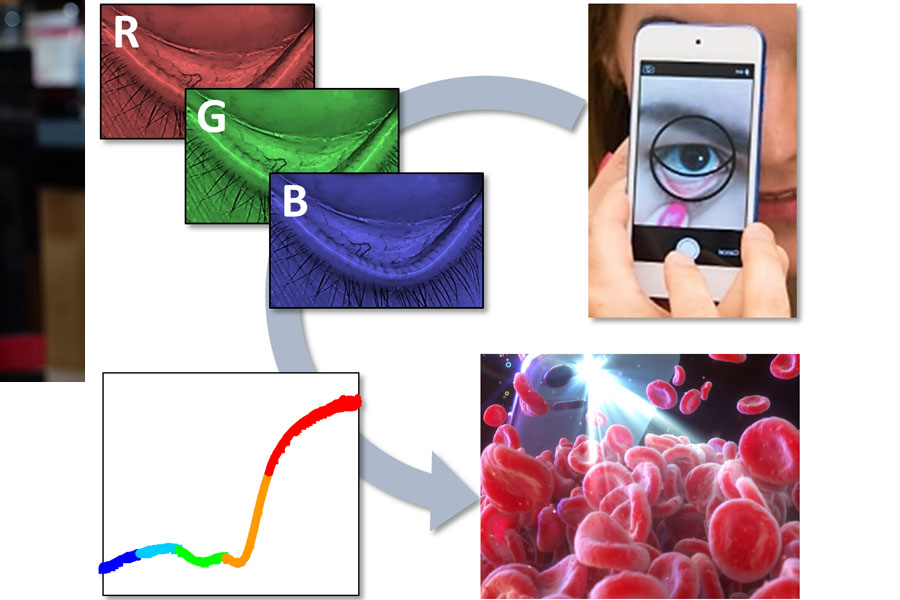Young Kim wins top NIH award for device that uses photo of eyelid to detect diseases

Young L. Kim created an algorithm that can conduct a noninvasive, point-of-care diagnosis of anemia and sickle cell disease. Earlier in 2020, Shah Family Global Innovation Lab at Global Engineering Programs and Partnerships (GEPP) facilitated a partnership with a team in India who helped provide complimentary resources and skills to further develop and pilot this technology in a low-resource setting in a rural region of Gujarat, India. The proposal earned Kim and the India team first place in the Tech Accelerator Challenge NTAC. The contest is led by the National Institute of Biomedical Imaging and Bioengineering (NIBIB), part of the National Institutes of Health (NIH).
His team for the India study includes: Pallavi Gupta at Shah Family Global Innovation Lab; Gauriji Hood and Ketan Mehta at Shrimad Rajchandra Hospital (SRH), Dharampur, India; and Abhishek Tiwari at Abhitech IT Solutions, Lucknow, India.
“Given the highly competitive funding environment, we need to be at the top of the game nowadays,” Kim said. “Any type of support from NIH is a great asset for maintaining the research in the lab and furthering its translation into impact, not only in the United States, but also throughout the world.”
Unlike typical NIH grants, the NTAC competition included entrants from universities as well as companies, Kim explained. “In this respect, I feel so fortunate that our data science research and development are attractive to the biomedical scientific communities.”
The technology is centered around an algorithm of spectral super-resolution spectroscopy that mathematically transforms the built-in camera of a smartphone into a hyperspectral imager, taking advantage of data science approaches.
There are many other mHealth technologies currently available for a variety of biomedical applications, Kim acknowledged, but they require an additional mandatory accessory and complex components that often limit practical translation.
“We took a different approach to completely minimize complicated hardware and avoid an additional smartphone attachment. Our data-driven approach allows us to conduct spectroscopic analyses without bulky spectroscopic instrumentation by just using a low-cost smartphone camera,” Kim said.
Kim selected the inner eyelid as the sensing site because the microvasculature there is quite visible. Another advantage: The inner eyelid’s spectra are not affected by skin color, which eliminates the need for any calibration for racial differences.
Once the picture is taken, the software breaks the image down to its spectral components. The app then compares the new information to what is learned from viewing a training set of images.
In addition to not requiring any additional attachments, the application has several other user-friendly advantages. “The hardware requirement is a standalone low-end smartphone,” Kim said, adding that the team’s testing was conducted on a Samsung Galaxy J3 that retails for less than $100. Also, the device is as easy to use as taking a photo on a smartphone, and the lifespan of the device is unlimited and can be used seamlessly when users upgrade their phones.
The initial algorithm development and clinical study took about three years and included collaborations with Moi University Teaching and Referral Hospital in Kenya via the Academic Model Providing Access to Healthcare (AMPATH) program. Kim expects to introduce a beta version of the app in about one year. “We are forming partnerships with several different entities for rapid commercialization and marketing,” he said.
One of the focuses of Kim’s lab is centered on “reciprocal innovation” – a term that refers to health care innovations and technologies that are designed and piloted in resource-limited settings. These are important solutions that can play a key role in alleviating health challenges in comparable demographics in developed countries as well as in developing countries, Kim said.
“Through SRH’s support, we also have reached out to the Department of Health and Family Welfare Government of Gujarat, who have shown interest in integrating the solution into their existing initiatives with frontline workers,” Gupta said.
Previously, Young’s technology had only been tested in Kenya, the country for which he developed the original algorithm. The result there served as the foundation for the NTAC competition, which required him to have a promising technology beyond the proof-of-concept stage. The prize money will help him expand his research to India, where he will further develop the device and enhance its capabilities.
Kim also serves as co-director of the Interdisciplinary Biomedical Science Program and has affiliations with Regenstrief Center for Healthcare Engineering, Purdue Quantum Science and Engineering Institute, and Purdue Center for Cancer Research.
